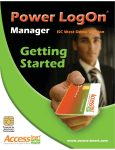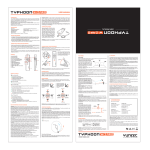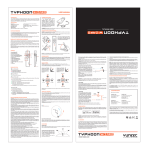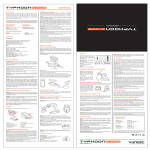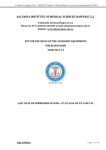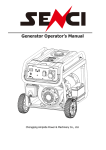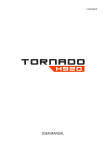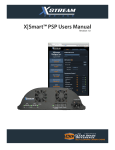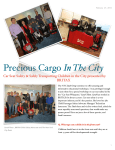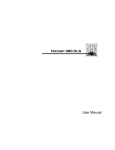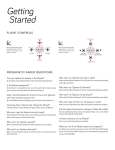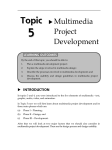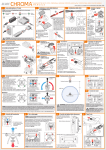Transcript
TYPHOON G 2015.0831 IMPORTANT NOTE: 2. INSTALLING THE PROPELLERS This Quick Start Guide is NOT intended to replace the content included in the instruction manual. You should read the instruction manual completely before proceeding. Install the corresponding A and B propellers in the positions shown by rotating them per the illustration and until they’re secure. It may also be helpful to use the included tool to hold the motors while installing the propellers. NOTICE: Please find a SD Card in the asseccory box. There are tutorial video, electronic user manual and show case in the SD Card. 1. CHARGING THE BATTERIES 4. PREPARING THE MK58 Step 1) Plug the audio connector into audio port of the MK58; then plug the 4PIN power connector into power output port of GB203. WARNING: Always operate TYPHOON in open areas (approximately 10000 square feet/930 square meters or more) that are free from people, vehicles, trees and other obstructions. Never fly near or above crowds, airports or buildings. STEP 2) Plug the MINI USB connector into USB interface of GoPro© Camera PROCESS IS COMPLETE. The main LED status indicator will glow solid green (Smart Mode) or solid purple (Angle/Pilot Mode) when initialization is complete (and TYPHOON GPS is locked). The GB203 LED status indicator will blink green slowly when initialization is completed. The MK58 will be supplied with power. Then the blue LED of the MK58 is on. Power the SC3500-3 charger from a 100-240V AC outlet using the AC adapter/power supply, or from a 12V DC accessory socket/cigarette lighter receptacle in a vehicle using the included adapter. 4PIN B Welcome,Pilot 10. STARTING/STOPPING THE MOTORS 10:48:28 pm 10 STEP 1) Bind the MK58 to the Personal Ground MODE VOLTS Angle 12.3 V Station/Remote Controller: Switch on the Personal GPS Ground Station/Remote Controller and tap "Flight ALT Ready 21.4 ft Setting". HOME A MINI USB 0.0 mph POS DIS 00.0000E 00.0000N 22.5 ft System Settings Never attempt to operate TYPHOON nearby tall buildings/obstructions that do not offer a clear view of the sky (a minimum clearance of 100°). Flight Settings Model: Typhoon Welcome,Pilot 10:48:28 pm 10 Camera Select Insert the GoPro© camera into the camera frame on the GB203, then thread the camera to secure position with the retaining screw. Do not over-tighten. Mode Select STEPHardware 3) Select "GoPro", tap "Select" and then tap Monitor TAKEOFF ZONE 26 ft (8m) A green blinking LED indicates the charger is powered on and ready to charge, and a red blinking LED indicates the battery is charging. It will take approximately 2 hours to charge a fully discharged (not over-discharged) battery. CAUTION: Do not over-tighten the propellers when using the tool. PILOT LOCATION 3. INSTALLING THE BATTERY If calibration is needed before flight, Please press calibration button enables the user to enter Compass calibration or Accelerometer calibration. The detailed calibration operation can be referred to the User Manual on www.yuneec.com. 8. CAMERA CONTROL Press here 6. PLACEMENT BEFORE TAKEOFF Step back approximately 26 feet (8 meters) behind TYPHOON. This side up WARNING: All instructions and warnings must be followed exactly to prevent property damage and/or serious injury as the mishandling of Li-ion/LiPo batteries can result in fire. If indoor flight is needed, please turn off the GPS first. Press setting button on ST10+ interface and switch off the GPS, 7. POWERING ON/OFF NOTE: If the door does not close, the battery is not inserted far enough to engage the connector properly. 10000 ft² (930m²) NOTE: ALWAYS turn the ST10+ on and allow it to boot up BEFORE turning TYPHOON on (and ALWAYS turn TYPHOON off BEFORE turning off the ST10+). Place TYPHOON on a level and stable surface then slide the switch to the ‘ON’ position. DO NOT TOUCH OR MOVE TYPHOON UNTIL THE INITIALIZATION Switch on the GoPro© camera. Please be sure to set video mode for GoPro© Camera BEFORE starting the motors of the aircraft. Any operation related to camera controls should be referred to and downloaded according to the official website of GoPro©. The MK58 from YUNEEC extends the use of the GB203 with real-time image transmission. "OK". Then the Camera Mode is chosen. Model: Typhoon Choose a camera Welcome,Pilot 10:48:28 pm 10 NAME: GOPRO STEP 4) Back to the previous interface and tap “Bind”. STEP 5) Select the MK58 in "Camera" interface . Model: Typhoon Step back approximately 26 feet (8 meters) behind TYPHOON. Press and hold the red START/STOP button for about 3 seconds to start, and about 2 seconds to stop the motors. 11. FLIGHT CONTROLS Bind 5. INSTALLING THE GOPRO© Welcome,Pilot Model 12. CONTROL RATE SLIDER Set the overall climb/descend and directional control rates. Use the turtle position for the lowest control rates (best for first-time pilots and when flying between 5000 feet and 8000 feet Above Mean Sea Level). Use the rabbit position for the highest control rates (best for experienced pilots and only when flying below 5000 feet AMSL. To takeoff, slowly raise the left-hand stick to slightly above the center position. TYPHOON will takeoff and climb slowly (or raise the stick further until it does). Allow the stick to return to the center position when TYPHOON reaches the desired altitude. Climb (Max. Altitude 400 Feet / 122 Meters) Maximum Climb Rate: 2m/s (6.6f/s) Maintain Altitude Descend / Land Mode 2 shown MK58 FLYING NOTICE: If install the GB203 on SteadyGrip, GoPro© APP can be downloaded to achieve real-time image transmission without MK58. STEP 6) Input password "12345678" and then tap CAUTION: The GoPro© Wi-Fi will interfere with the quadcopter receiver and may cause a loss of signal and crash. Follow the camera instructions to turn the Wi-Fi off before attempting to power on the quadcopter. Crash damage is not covered under warranty. the MK58 are bound, the red LED of the MK58 will blink. Press to return to the main interface of the Ground Station/Controller. The real-time images can be shown on the interface of the Ground Station/ Controller. "OK". The binding succeeds. STEP 7) After the Ground Station/ Controller and Additional Smart Mode Features: SMART MODE FOLLOW ME FUNCTION When the Flight Mode Selection Switch is the top position TYPHOON will be in Smart Mode. Although we recommend learning to fly TYPHOON in Angle (Pilot) Mode as soon as possible, Smart Mode is typically the best mode for first-time pilots to fly in and also features ‘Follow Me’. IMPORTANT NOTE: If at any time during flight you feel like TYPHOON is drifting out of/beyond your control, simply release both control sticks. TYPHOON will automatically self-level and will even hold its position (with a suitable GPS signal/lock) when both control sticks are centered. You can also activate Home Mode so TYPHOON automatically land within 13-26 ft (4-8m) of the pilot. This illustration applies when the controller is pointed towards the aircraft LANDING 13. SELECTING A FLIGHT MODE There are two ways to land TYPHOON: TYPHOON is programmed with three (3) flight modes that can be selected via the Flight Mode Selection Switch located just above the right-hand control stick. Usually, the default function under Smart Mode is Follow Me. Watch Me function can be switched to by following steps: The Follow Me function allows the TYPHOON to follow the pilot, adjusting its location to the location of the ST10+. This function is enabled when ST10+ GPS positioning completes, and the TYPHOON is using shared GPS signal with the ST10+. At this time, you will see orange , and green follow in MODE Follow . When in Follow Me function, the TYPHOON will In Watch Me function, the pilot will always be kept in the frame wherever he moves. Model: TYPHOON Take your time learning how TYPHOON responds to various control inputs while flying. In Smart Mode TYPHOON will always move in the direction the right-hand control stick is pushed relative to the pilot and no matter which way the front/nose is pointed. In Angle (Pilot) Mode TYPHOON will move in the direction the control stick is pushed relative to the front/nose of the aircraft (and the ‘angle’ of movement is determined by how far you push the WARNING: Always land as soon as possible after the first low level voltage battery warning, or land immediately after the second level low voltage battery warning (as indicated by the vibrations and audible alerts from the ST10+, and by the Below Motor LED Status Indicators flashing rapidly). And if at any time the Aircraft Battery Voltage shown on the screen is below 10.7V, land TYPHOON immediately. AFTER LANDING ALWAYS turn off TYPHOON BEFORE turning off the ST10+. Then remove the battery from TYPHOON and allow it to cool to ambient/room temperature before recharging. Welcome,Pilot 10:48:28 pm 10 MODE VOLTS Follow follow the movement of ST10+ if there is no extra operation on the ST10+. The flight status is also controllable when you operate ST10+ and GB203. IMPORTANT NOTE: In Follow Me function, the aircraft will maintain a constant altitude and cannot detect obstacles. Pilots who change their altitude by for example, moving to higher ground, during flight should be mindful of this. 12.3 V GPS ALT Ready 21.4 ft SAT G-SPD 13 0.0 mph POS DIS Watch in xSmart 00.0000E Me/Follow Me Button: When 3840 2160 F30 Mode, press 22.5 ft 00.0000N to switch the TYPHOON between Watch Me and Follow me function. Follow Me function is the default Model setting, and System Settings Flight Settings Select the button is ORANGE. If it is GREY, it means ST10+ GPS isn’t ready yet. Please wait. Model: TYPHOON Welcome,Pilot 10:48:28 pm 10 MODE VOLTS watch 12.3 V GPS ALT Ready 2) Activate Home Mode and TYPHOON will automatically fly itself back to the home point and will land within a 10 foot (3 meter) diameter circle around it. 10:48:28 pm 10 Camera Mode 2 shown 1) Position TYPHOON above the area where you would like to land. Slowly lower the left-hand stick to below the center position. TYPHOON will descend slowly and land. After TYPHOON lands, press and hold the red START/STOP button until the motor stop. 14. FLIGHT MODES In Smart Mode TYPHOON will always move in the direction the right-hand control stick is pushed relative to the pilot and no matter which way the front/nose is pointed. So if you push the stick to the left TYPHOON will always move to the left, regardless of the direction the nose is pointing and even if it’s spinning. This mode can also be helpful for pilots that lose orientation while flying in Angle (Pilot) Mode. Model Select STEP 2) Select "Camera Select". Be sure to place TYPHOON on a level and stable surface before powering ON the Controller and Aircraft. stick away from the center position). And please see the corresponding sections of this instruction manual for more information on Smart Mode and Angle (Pilot) Mode. G-SPD 13 Audio Connector B Model: Typhoon SAT 100˚ A 9. BINDING THE MK58 21.4 ft SAT G-SPD 13 0.0 mph DIS POS 00.0000E Press , the button will change from ORANGE 22.5 ftto 00.0000N GREEN. And now it is in Watch Me function. System Settings Flight Settings Model Select NOTE: Once the TYPHOON is above 2m and out of Smart Circle during flying, the TYPHOON yaw direction will take the control itself. Camera lens will always point to you as long as Flight Mode Selection Switch is in Smart Mode. Please put the GB203 Pitch Angle/Position Control Slider in the middle position. If you want to trim camera angle up, then just move the Pitch Angle/Position Control Slider a bit up. If you want to trim camera angle down, just move the slider down. 3840 x 2160 F30 Smart Circle 1) When the flight mode switch is in the top position TYPHOON will be in Smart Mode. WATCH ME FUNCTION 2) When the flight mode switch is in the middle position TYPHOON will be in Angle (also known as Pilot) Mode. 3) When the flight mode switch is in the lowest position TYPHOON will be in Home Mode. Mode 2 shown Watch Me function enables the camera to keep tracking the remote controller no matter where and how it moves as the camera can automatically tilt its angle according to the controller. GEO-FENCE The geo-fence is a virtual ‘barrier’ that will keep TYPHOON from traveling further than 300 feet (91 meters). Although this limit can be adjusted using the USB interface/programmer and software we strongly recommend using the default limit at all times. WARNING: Smart Mode only works when TYPHOON has a suitable GPS signal/lock. If you take off in Smart Mode and TYPHOON loses GPS signal/lock it will switch to Angle (Pilot) Mode automatically. This is why we strongly recommend learning to fly in Angle (Pilot) Mode as soon as possible. Otherwise, if you lose GPS signal/lock and are not able to properly control TYPHOON in Angle (Pilot) Mode the aircraft may crash or even ‘fly away’. WARNING: If you do not properly control TYPHOON in Angle (Pilot) Mode the aircraft may crash or even ‘fly away’. IMPORTANT NOTE: Crash damage and ‘fly aways’ are NOT covered under warranty. HOME MODE When the Flight Mode Selection Switch is in the bottom position TYPHOON will be in Home (also known as Return to Home) Mode. LANDING LOCATION Angle (Pilot) Mode is the mode preferred by experienced RC/drone pilots because TYPHOON will move in the direction the control stick is pushed relative to the front/nose of the aircraft. So if you push the right-hand stick to the left TYPHOON will bank toward the left side and move to the left. This means if the front/nose of TYPHOON is pointing away from you it will move to the left, but if the front/nose is pointing at you TYPHOON will move to the right. Additional Angle Mode Feature: (Pilot) POSITION HOLD SELF-LEVELING AND TYPHOON will automatically hold its position (with a suitable GPS signal/lock) and maintain a level attitude when the right-hand stick is centered. SMART CIRCLE In most cases the Smart Circle will keep TYPHOON from coming within approximately 26 feet (8 meters) of you (as long as you position yourself at least 26 feet/8 meters behind TYPHOON. 13-26 ft (4-8m) PILOT LOCATION In Home Mode the GPS connectivity will fly back TYPHOON in a straight line in the direction of the pilots’ current location, and automatically land within 13-26 ft (4-8m) of the pilot. This can be very helpful for first-time pilots who aren’t quite ready to land TYPHOON themselves. It can also be helpful for pilots that lose orientation during flight; simply activate Home Mode until TYPHOON automatically moves toward the home position, and once you’ve confirmed orientation switch back to Angle (Pilot) Mode. And if TYPHOON ever loses the link with the ST10+ it will automatically enter Home Mode. When Home Mode is activated TYPHOON will respond as follows: > Mode 2 shown AGE RECOMMENDATION: NOT FOR CHILDREN UNDER 14 YEARS. THIS IS NOT A TOY. GENERAL SAFETY PRECAUTIONS AND WARNINGS WARNING: Failure to use this product in the intended manner as described in the quick start guide and instruction manual can result in damage to the product, property and/or cause serious injury. A Radio Controlled (RC) multirotor aircraft, APV platform, drone, etc. is not a toy! If misused it can cause serious bodily harm and damage to property. WARNING: As the user of this product you are solely and wholly responsible for operating it in a manner that does not endanger yourself and others or result in damage to the product or the property of others. Keep your hands, face and other parts of your body away from the spinning propellers/rotor blades and other moving parts at all times. Keep items that could impact or become entangled away from the propellers/rotor blades including debris, parts, tools, loose clothing, etc. Always operate your aircraft in open areas that are free from people, vehicles and other obstructions. Never fly near or above crowds, airports or buildings. To ensure proper operation and safe flight performance never attempt to operate your aircraft nearby buildings or other obstructions that do not offer a clear view of the sky and can restrict GPS reception. Do not attempt to operate your aircraft in areas with potential magnetic and/or radio interference including areas nearby broadcast towers, power transmission stations, high voltage power lines, etc. Always keep a safe distance in all directions around your aircraft to avoid collisions and/or injury. This aircraft is controlled by a radio signal subject to interference from many sources outside your control. Interference can cause momentary loss of control. To ensure proper and safe operation of the automatic landing function in Home Mode you must start the motors with the aircraft in a position that has at least 10 feet (approximately 3 meters) of clear and open space around it and achieve a proper GPS lock. Do not attempt to operate your aircraft with any worn and/or damaged components, parts, etc. (including, but not limited to, damaged propellers/rotor blades, old batteries, etc.). Never operate your aircraft in poor or severe weather conditions including heavy winds, precipitation, lightning, etc. Always operate your aircraft starting with a fully charged battery. Always land as soon as possible after the first level low voltage battery warning or land immediately after the second level low voltage battery warning (as indicated by the vibrations and audible alerts from the transmitter/personal ground station). Always operate your aircraft when the voltage of the battery in the transmitter/personal ground station is in a safe range (as indicated by the battery charge status icon on the screen of the transmitter/personal ground station). Always keep the aircraft in clear line of sight and under control, and keep the transmitter/personal ground station powered on while the aircraft is powered on. Always move the throttle control stick down fully and turn off the motors in the event the propellers/rotor blades come into contact with any objects. Always allow components and parts to cool after use before touching them and flying again. Always remove batteries after use and store/transport them per the corresponding guidelines. Avoid water exposure to all electronic components, parts, etc. not specifically designed and protected for use in water. Moisture causes damage to electronic components and parts. Never place any portion of the aircraft or any related accessories, components or parts in your mouth as doing so could cause serious injury or even death. Always keep chemicals, small parts and electronic components out of the reach of children. Carefully follow the instructions and warnings included with this aircraft and any related accessories, components or parts (including, but not limited to, chargers, rechargeable batteries, etc.). CAUTION: The electronic speed controls (ESCs) installed in TYPHOON are not compatible with any other product, and TYPHOON is not compatible with any other ESCs. Use of any other ESCs in TYPHOON will cause a crash, which may result in damage to the product, property and/or cause serious injury. BATTERY WARNINGS AND USAGE GUIDELINES WARNING: Lithium Polymer (LiPo) batteries are significantly more volatile than alkaline, NiCd or NiMH batteries. All instructions and warnings must be followed exactly to prevent property damage and/or serious injury as the mishandling of LiPo batteries can result in fire. By handling, charging or using the included LiPo battery you assume all risks associated with LiPo batteries. If you do not agree with these conditions please return the complete product in new, unused condition to the place of purchase immediately. This equipment must be installed and operated in accordance with provided instructions and the antenna(s) used for this transmitter must be installed to provide a separation distance of at least 20 cm from all persons and must not be co-located or operating in conjunction with any other antenna or transmitter. End-users and installers must be provide with antenna installation instructions and transmitter operating conditions for satisfying RF exposure compliance. N/A V ALT N/A ft SAT G-SPD N/A N/A mph POS DIS N/A E N/A N N/A ft Flight Settings 1) Flight Mode of Aircraft 2) GPS Status for Aircraft 3) Watch Me/Follow Me Button 4) In Flight Settings IMPORTANT NOTE: After flying, turn off TYPHOON BEFORE turning off the ST10+. Then remove the battery from TYPHOON and allow it to cool to ambient/room temperature before recharging. Double tap the center of the screen to increase the size of the video viewing area. Any information above might be changed due to the software update. For the latest documents, please check the official website. THE FOLLOWING DOCUMENTS ARE AVAILABLE FOR DOWNLOAD AT WWW.YUNEEC.COM/SUPPORT • • • • • • B The full TYPHOON G Manual Calibration Sheet LED Status Indication Sheet Graphic User Interface Firmware Updates Tutorial Videos Use the slider (A) on the left side of the ST10+ to set the pitch/tilt position (B) of the GB203. OVERVIEW 13 6 14 15 9 16 10 17 11 18 12 19 20 22 7 1 2 3 4 5 6 7 GB203 GB203 LED Status Indicator Main LED Status Indicator Power Switch MK58 Proportional Control Rate Slider USB Connector/Charging Port 8 9 10 11 12 Audio/Earphone Jack Take Still Photo Button (disabled) Start/Stop Motors Button Rudder/Yaw Control (for Mode 2 and Mode 1) Throttle/Altitude Control (for Mode 2) Elevator/Pitch Control (for Mode 1) 13 5.8GHz Antenna (located inside the case) 23 8 3 4 5 21 14 15 16 17 18 19 Status Indicators (for ST10+ battery, 5.8GHz WiFi and GPS) 2.4GHz Antenna (located inside the handle) Start/Stop Video Recording Button (disabled) Flight Mode Selection Switch Aileron/Roll Control (Mode 2 and Mode 1) Elevator/Pitch Control (Mode 2) Throttle/Altitude Control (Mode 1) IC RADIATION EXPOSURE STATEMENT FOR CANADA This device complies with Industry Canada licence-exempt RSS standard(s). Operation is subject to the following two conditions: (1) this device may not cause interference, and (2) this device must accept any interference, including interference that may cause undesired operation of the device. Le présent appareil est conforme aux CNR d'Industrie Canada applicables aux appareils radio exempts de licence. L'exploitation est autorisée aux deux conditions suivantes : (1) l'appareil ne doit pas produire de brouillage, et (2) l'utilisateur de l'appareil doit accepter tout brouillage radioélectrique subi, même si le brouillage est susceptible d'en compromettre le fonctionnement. This equipment complies with IC RSS-102 radiation exposure limit set forth for an uncontrolled environment. Cet équipement respecte les limites d'exposition aux rayonnements IC définies pour un environnement non contrôlé TYPHOON G V1.0 4 Model Select WARNING: NEVER attempt to fly TYPHOON via First-Person View (FPV). Attempting to fly via FPV can result in a crash that will cause damage to the product, property and/or cause serious injury. 15. GIMBAL CONTROLS FCC STATEMENT: RF EXPOSURE WARNING VOLTS N/A N/A System Settings CAUTION: You must be certain there are no obstacles in the ‘Return to Home’ flight path otherwise TYPHOON may come into contact with them and crash. While TYPHOON is in Home Mode you will have a limited amount of directional control. To help avoid obstacles we strongly recommend to switch to Smart or Angle Mode (then you can switch back to Home Mode). WARNING: Home Mode only works when TYPHOON has a suitable GPS signal/lock. If TYPHOON loses GPS signal/lock it will switch to Angle (Pilot) Mode automatically. This is why we strongly recommend learning to fly in Angle (Pilot) Mode as soon as possible. Otherwise, if you lose GPS signal/lock and are not able to properly control TYPHOON in Angle (Pilot) Mode the aircraft may crash or even ‘fly away’. IMPORTANT NOTE: Crash damage and ‘fly aways’ are NOT covered under warranty. You must always charge the LiPo battery in a safe, well-ventilated area away from flammable materials. Never charge the LiPo battery unattended at any time. When charging the battery you must always remain in constant observation to monitor the charging process and react immediately to any potential problems that may occur. After flying/discharging the LiPo battery you must allow it to cool to ambient/room temperature before recharging. To charge the LiPo battery you must use only the included charger or a suitably compatible LiPo battery charger. Failure to do so may result in a fire causing property damage and/or serious injury. If at any time the LiPo battery begins to balloon or swell, discontinue charging or discharging immediately. Quickly and safely disconnect the battery, then place it in a safe, open area away from flammable materials to observe it for at least 15 minutes. Continuing to charge or discharge a battery that has begun to balloon or swell can result in a fire. A battery that has ballooned or swollen even a small amount must be removed from service completely. Do not over-discharge the LiPo battery. Discharging the battery too low can cause damage to the battery resulting in reduced power, flight duration or failure of the battery entirely. LiPo cells should not be discharged to below 3.0V each under load. Store the LiPo battery at room temperature and in a dry area for best results. When charging, transporting or temporarily storing the LiPo battery the temperature range should be from approximately 40–120° F (5–49° C). Do not store the battery or aircraft in a hot garage, car or direct sunlight. If stored in a hot garage or car the battery can be damaged or even catch fire. Never leave batteries, chargers and power supplies unattended during use. Never attempt to charge low voltage, ballooned/swollen, damaged or wet batteries. Never allow children under 14 years of age to charge batteries. Never charge a battery if any of the wire leads have been damaged or shorted. Never attempt to disassemble the battery, charger or power supply. Never drop batteries, chargers or power supplies. Always inspect the battery, charger and power supply before charging. Always ensure correct polarity before connecting batteries, chargers and power supplies. Always disconnect the battery after charging. Always terminate all processes if the battery, charger or power supply malfunctions. This equipment has been tested and found to comply with the limits for Part 15 of the FCC rules. These limits are designed to provide reasonable protection against harmful interference in a residential installation. This equipment generates, uses and can radiate radio frequency energy and, if not installed and used in accordance with the instructions, may cause harmful interference to radio communications. However, there is no guarantee that interference will not occur in a particular installation. If this equipment does cause harmful interference to radio or television reception, which can be determined by turning the equipment off and on, the user is encouraged to try to correct the interference by one or more of the following measures: Reorient or relocate the receiving antenna. Increase the separation between the equipment and receiver. Connect the equipment to an outlet on a circuit different from that to which the receiver is connected. This device complies with part 15 of the FCC rules. Operation is subject to the following two conditions: (1) This device may not cause harmful interference, and (2) this device must accept any interference received, including interference that may cause undesired operation. NOTE: This equipment has been tested and found to comply with the limits for a Class B digital device, pursuant to part 15 of the FCC Rules. These limits are designed to provide reasonable protection against harmful interference in a residential installation. This equipment generates, uses and can radiate radio frequency energy and, if not installed and used in accordance with the instructions, may cause harmful interference to radio communications. However, there is no guarantee that interference will not occur in a particular installation. If this equipment does cause harmful interference to radio or television reception, which can be determined by turning the equipment off and on, the user is encouraged to try to correct the interference by one or more of the following measures: —Reorient or relocate the receiving antenna. —Increase the separation between the equipment and receiver. —Connect the equipment into an outlet on a circuit different from that to which the receiver is connected. —Consult the dealer or an experienced radio/TV technician for help. 07:25 GPS 2 A A 3 Welcome,Pilot MODE 1 10 m ANGLE (PILOT) MODE When the Flight Mode Selection Switch is the middle position TYPHOON will be in Angle (also known as Pilot) Mode. Model:TYPHOON B) When flying lower than 33 feet (10 meters) TYPHOON will climb to 33 feet (10 meters) while flying back to the home point, or active home position, then will descend vertically until it lands. IMPORTANT NOTE: Crash damage and ‘fly aways’ are NOT covered under warranty. IMPORTANT NOTE: When the ST10+ Personal Ground Station is connected to less then 6 satellites, the ‘FOLLOW ME’ feature will be disabled. 16. ST10+ DISPLAY B NOTICES AND WARNINGS IMPORTANT NOTE: All safety precautions and warnings, instructions, warranties and other collateral information is subject to change at the sole discretion of Yuneec. For the most up-to-date information please visit the corresponding product page at www.Yuneec.com or contact the nearest Yuneec office or authorized distributor. The following special language terms are used throughout the product literature to indicate various levels of potential harm when operating this product: NOTICE: Procedures, which if not properly followed, create a possibility of property damage and/or little to no possibility of injury. CAUTION: Procedures, which if not properly followed, create the probability of property damage and/or a possibility of serious injury. WARNING: Procedures, which if not properly followed, create the probability of property damage, collateral damage and/or serious injury or create a high probability of superficial injury. WARNING: Read the ENTIRE quick start guide and instruction manual to become familiar with the features of the product before operating. Failure to operate the product correctly can result in damage to the product, property and/or cause serious injury. WARNING: This is a sophisticated consumer product. It must be operated with caution and common sense, and requires some basic mechanical ability. Failure to operate this product in a safe and responsible manner could result in damage to the product, property and/or cause serious injury. This product is not intended for use by children without direct adult supervision. Do not use with incompatible components or alter this product in any way outside of the instructions provided by Yuneec. The quick start guide and instruction manual contain instructions for safety, operation and maintenance. It is essential to read and follow all the instructions and warnings prior to assembly, setup and/or use in order to operate the product correctly and avoid damage or serious injury. A) When flying higher than 33 feet (10 meters) TYPHOON will maintain the current altitude, fly back to the home point, or active home point if the ST10+ has enough satellites for Follow Me, then descend vertically until it lands. 20 Power Switch 21 Volume and Navigation Touch-Activated Buttons Volume Down/VolumeUp/Menu/Home/Back) 22 Gimbal Pitch Angle/Position Control Slider 23 SD Card Slot (located under the battery)





